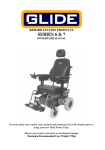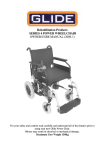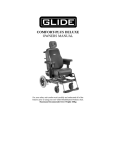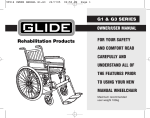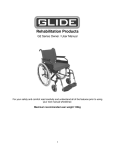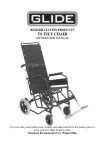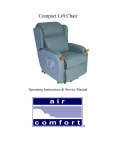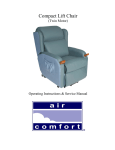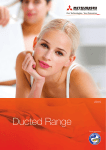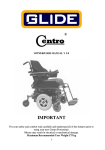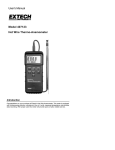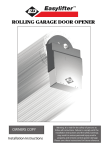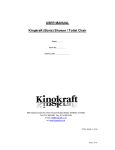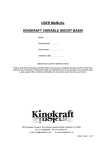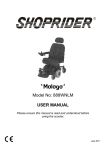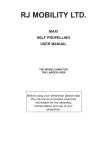Download User Manual Lightweight Wheelchair
Transcript
TABLE OF CONTENTS INTRODUCTION PAGE No 2 PRODUCT SPECIFICATIONS INCLUDED EXTRAS OPTIONS ASSEMBLY INSTRUCTIONS 2 FOLDING & OPENING INSTRUCTONS TRANSPORTING YOUR WHEELCHAIR USE OF YOUR MANUAL WHEELCHAIR 3 3 COMMON MISUSE OF MANUAL WHEELCHAIRS DESCENDING/ASCENDING STEEP GRADIENTS CROSSING KERBS & OBSTACLES USE OF YOUR MANUAL WHEELCHAIR 4 DESCENDING FROM KERBS & OBSTACLES BREAKDOWN OF MAIN WHEELCHAIR COMPONENTS 5 FOOT RESTS ARM RESTS BRAKES BREAKDOWN OF MAIN WHEELCHAIR COMPONENTS 6 LARGE WHEELS 24 INCH FORKS AND CASTORS CLEANING YOUR WHEELCHAIR 6 UPHOLSTERY FRAME GENERAL SERVICING WARRANTY K•CARE CONTACT DETAILS 7 1 INTRODUCTION We at K•Care would like to thank you for selecting one of our lightweight wheelchairs The K•Care range of lightweight wheelchairs are manufactured from powder coated aluminium, with nylon upholstery. Safe maximum user weights are as follows. • W16 – 120 kilograms • W18 – 120 kilograms • W18T – 120 kilograms Your new wheelchair should provide years of trouble free use, provided you read and implement the recommendations in this manual. Please take the time to read this manual and familiarise yourself with the features and functions of your wheelchair before operating it for the first time. If you have any queries about the functions of this wheelchair, or are interested in another product in our extensive range, please contact your local K•Care Distributor or place of purchase for details. PRODUCT SPECIFICATIONS DIMENSIONS W16 W18 W18T Overall width (opened) Overall width (folded) Floor to top front of seat Seat width (between arms) Seat depth Floor to top of push handles 600mm 290mm 500mm 400mm 400mm 940mm 650mm 300mm 500mm 450mm 400mm 940mm 600mm 250mm 500mm 450mm 400mm 940mm INCLUDED EXTRAS Your lightweight wheelchair comes with a pair of push button anti-tilt wheels, and a leg rest adjustment tool. ASSEMBLY INSTRUCTIONS Assembly of the wheelchair is quite simple as it is almost completely pre-assembled by the manufacturer. • Firstly, remove the plastic bag from the chair, and open the wheelchair up. • Then take the swing away leg rests out of the cardboard box, insert leg rests onto the locating pins, and swing them in for automatic locking. • Fit anti tilt wheels to the frame. The mounting points are located at the bottom rear of the frame. • The W18 wheelchair is fitted with quick release rear wheels, please ensure that they are secured in place. • Before using your wheelchair for the first time, ensure tyre pressures are correct and brakes function correctly. PLEASE NOTE The K•Care range of wheelchairs has been designed with general-purpose use in mind and is suitable for both indoor and outdoor environments. However, it is not intended to be used as a heavy-duty device; therefore we recommend that it be kept away from prolonged exposure to extreme conditions such as direct sunlight & extremes of temperature. FOLDING AND OPENING INSTRUCTIONS Folding • Before folding, flip up footplates to the vertical position. • Grasp the seat upholstery by the stitched in handles on the seat and lift upwards. Opening • Take your position at the front of the wheelchair. • Press down in the centre of the upholstery bars. 2 TRANSPORTING YOUR CHAIR K•Care does not recommend that you travel in a vehicle whilst sitting in your wheelchair. Where possible, wheelchair occupants should be transferred into a seat and use the proper vehicle seat restraints. However, if you wish your chair to be transported in a vehicle, your vehicle wheelchair restraint system must comply with AS2942-1994. COMMON MISUSE OF MANUAL WHEELCHAIRS There are several common misuses of wheelchairs known to K•Care that may lead to personal injury or damage to the wheelchair. • Not utilising correct lifting techniques when lifting the wheelchair. • Using the wheelchair when the pneumatic wheels are flat or only partially inflated may lead to tyre tube damage. • This wheelchair has not been designed to be used in a wet environment (shower, pool, etc). Exposure to large amounts or long periods of moisture may lead to deterioration of the product. • Do not leave an occupant unattended in a transporter wheelchair. USE OF YOUR MANUAL WHEELCHAIR Descending/ascending steep gradients When transferring either into, or out of the wheelchair, the braking mechanisms must be activated. Using the wheelchair in difficult situations such as steep gradients, side angled pathways and obstacles may be hazardous. We recommend the following methods should be used to avoid tipping over: Picture One • • • Picture Two By leaning the body forward, the stability of the wheelchair can be improved greatly when ascending a gradient (as can be seen in Picture One). On downward gradients, the back should be in a straight position, with the speed and direction of the wheelchair controlled by the user utilising the push rims, not by riding the brakes (as can be seen in Picture Two). Under normal conditions (clean and dry surface with no side angle) it is possible to climb slopes safely of up to thirteen degrees. Crossing kerbs/obstacles We recommend that when accessing difficult terrain, unless you are an experienced or strong wheelchair user, that an attendant be present. The attendant can tilt the chair back using the handgrips and the rear tilt bars. When an attendant is not present, we recommend that you avoid difficult terrain and obstacles such as kerbs, by utilizing provided walkways, wheelchair access points, etc. If these are not available and kerbs need to be accessed, carefully lift the castors over the top of the kerb then ease the rest of the chair forward. This practice should only be attempted by experienced and strong wheelchair users. 3 Descending from kerbs/obstacles Picture Three Picture Four Rolling forward and keeping the back in an upright position should allow you to safely descend from a kerb (Picture Three). Higher obstacles can be dealt with by approaching the kerb in a reverse position. Bring the two large rear wheels to the edge of the obstacle and slowly easing your chair down using the push rim as a steady/brake. Improve your stability by leaning your body forward in the chair throughout this maneuver (Picture Four). BREAKDOWN OF MAIN WHEELCHAIR COMPONENTS Ergonomic push handles 24” pneumatic wheels Padded armrest Swing back side arm User operated hand brake Removable, swing away leg rest Anti tilt bars Fold up footplate 8” solid castors 4 LEG RESTS The swing away leg rests provided on the K•Care wheelchairs are removable and feature fold up footplates. To remove: • Pull lever outwards to allow the leg rest to swing outwards. • Lift upwards to remove from mounting pins To install: • Insert footrest back on the mounting pins and swing inwards. • The lever will automatically click into a locked position. To adjust footplates: • Remove hexagonal head bolt (with tool provided with your wheelchair). • Move up or down until desired height is achieved. • Replace the hexagonal head bolt and tighten. ARM RESTS The armrests provided on our wheelchairs are of full length, and include a full-length padded top arm. The armrest has a swing back feature to assist with side transfer of user, and when positioning the wheelchair close to a table. To remove: • Push button and hold in on front of arm socket. • Using your other hand, lift the armrest upwards and back. To install: • Swing arm back down and forward, push into place until an audible “click” lets you know the arm is locked back in place. • Never lift the wheelchair by its arm rests as damage may occur. BRAKES The brakes should not be used for slowing the wheelchair. Brakes are designed as a locking device only and should be applied when the wheelchair is stationary. Use the push rims as a means of slowing the wheelchair. The brakes should be checked on a regular basis, or when you notice that their performance is starting to diminish. Brake Adjustment • Check that the large rear tyres have been inflated to a correct pressure before making any brake adjustments. • Loosen the nut on brake body and adjust the brake so that when the lever is in the locked position the wheel is firmly held by the brake arm. • Re-tighten the locking nut. • The bars should not rub against the tyre when the brakes are in the off position. • If rolling occurs when both brakes have been applied, the brakes have not been adjusted far enough, repeat the above process. 5 LARGE WHEELS 24-INCH The large wheels on the W18 are fitted with a quick release mechanism. The wheel is removed simply by pushing in the hub button, and pulling the wheel off the frame. On the W16 model, a nut secures the rear wheels and axle. Refer below for removal. The large rear wheel tyres should only be replaced in pairs. Worn and/or under inflated tyres may make the wheelchair difficult to steer and propel, always maintain correctly inflated tyres in order to minimize these problems and to maximize tyre lifespan. Rear wheels should be inflated to manufacturer’s recommended pressure, refer to sidewall of tyre for correct pressure settings. To remove large rear wheels (W16 model) • Remove dust cap. • Unscrew the locking nut and unscrew the axle bolt, remove axle bolt. • To reinstall, reverse the above procedure. FORKS AND CASTORS To remove fork with castor • Remove dust cap. • Unscrew the locking nut and remove fork with attached castor. • To reinstall, reverse the above procedure. CLEANING YOUR WHEELCHAIR With a regular cleaning routine, you can preserve the appearance of your wheelchair for a very long time. Listed below are some simple procedures that will make cleaning your wheelchair easier. UPHOLSTERY The build up of body oils/sweat, hair or fluff can lead to the deterioration of the upholstery. Cleaning should be performed approximately once a week/fortnight. To Clean • Vacuum upholstery, any staining may be removed with a mild soap and warm water. Stubborn grime may require gentle scrubbing with a soft brush. • When finished, allow to air dry or dry with a soft cloth. PLEASE NOTE Never use furniture polishes, abrasive cleaners or steel wool on this wheelchair as it may severely damage the finish of the chair. Regular use of cleaners containing hydrocarbons or similar additives may cause damage to the upholstery and possibly leading to permanent degradation of the product. We recommend that you replace broken upholstery screws immediately to avoid potential tearing of the vinyl. Ensure stretched, torn or split upholstery is replaced for your safety. FRAME To Clean • Simply wipe over the frame once a week with a soft cloth and a mild evaporative cleaner such as glass/window cleaner to remove any prints/smudges, this will restore the frame’s finish. 6 GENERAL SERVICING Approximately every 3 months or so, we recommend that you perform the following routine to maximize the useful lifespan of your wheelchair. • Check castor/rear wheel play, remove dust caps and ensure area around the axle’s locking nut is free of dust and debris. • Check brakes and adjust if necessary. • Ensure that all nuts and screws on the frame are tight. • Check the large rear Nylon wheels for cracked or broken spokes. The wheel should be replaced immediately. If replacement parts are ever required (such as tyres, tubes, footplates, etc), please contact your nearest K•Care distributor for pricing and availability of materials. WARRANTY • • • • K•Care warrants our range of wheelchairs for a period of twelve (12) months from date of purchase. K•Care or an authorised K•Care Distributor must inspect the product within the warranty period. K•Care is not liable for any costs borne from the shipping of non-conforming product to place of inspection (e.g. distributor address). K•Care’s warranty does not cover product damaged accidentally through misuse or neglect. K•Care does not warrant product that has been modified from its original form. Due to logistical reasons, it is imperative that you contact your place of purchase who will lodge an official complaint/claim on your behalf. K•CARE CONTACT DETAILS HEAD OFFICE K•Care Perth 100 Mulgul Road Malaga WA 6090 Australia Telephone +61 8 9248 4444 Facsimile +61 8 9248 4190 Email [email protected] Website www.hillshealthcare.com.au 7







